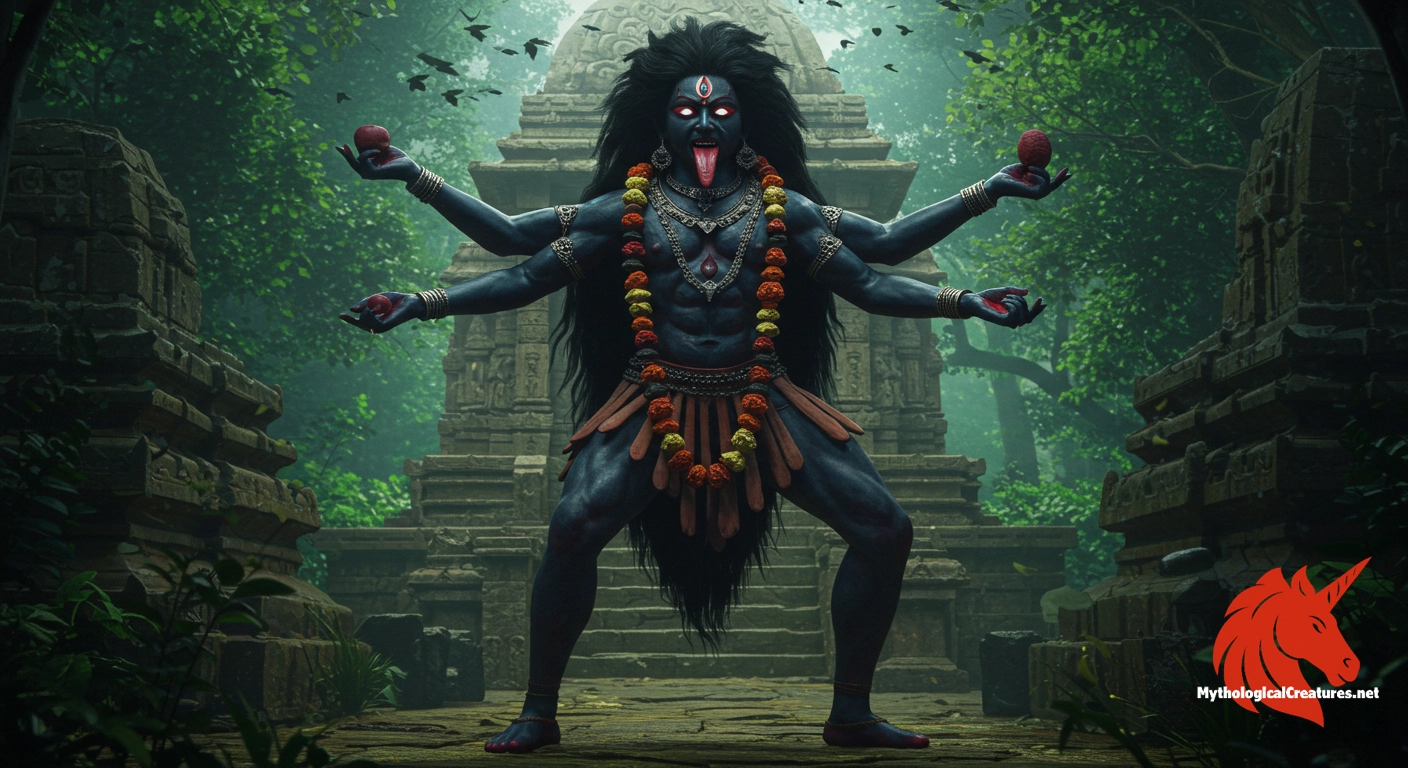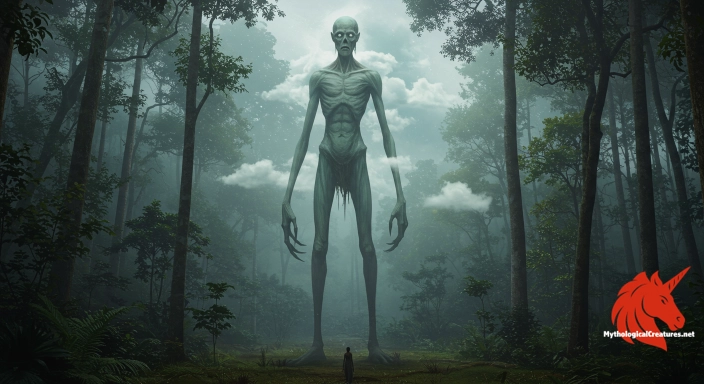Kali: Kali is a major Hindu goddess associated with time, death, and destruction.

Kali
Kali - Represents the fierce aspect of the divine feminine, embodying both creative destruction and the path to liberation.
Origins & First Encounters
Kali is a formidable and multi-dimensional goddess whose presence embodies the profound forces of time, death, and destruction, alongside the promise of transcendental wisdom. Her emergence from ancient pre-Vedic and Vedic traditions laid the early foundations of goddess worship in the Indian subcontinent. She is celebrated as the Divine Mother, whose nurturing essence coexists with an awe-inspiring ferocity. The rich tapestry of her character is woven through legends that honour both her protective nature and her relentless drive to dissolve the boundaries of mortal existence. Over time, Kali became a central figure within the Mahavidyas and the tantric tradition, reflecting a synthesis of the fierce and the compassionate. Her first major literary appearance in texts such as the Devi Mahatmya marked a pivotal moment in the codification of her legend. As centuries passed, the evolving cultural context imbued her with new layers of meaning, positioning her as a symbol of both cosmic destruction and eventual regeneration. Her enduring appeal lies in this delicate balance, which continues to inspire devotion and challenge conventional perceptions of creation and dissolution.
Source Texts & Tale Variants
Ancient scriptures and tantric treatises provide a wealth of narratives that reveal the multifaceted nature of Kali. The Devi Mahatmya, a seminal sixth-century text, is renowned for establishing her identity as a powerful force against chaos. Various story variants portray her both as a nurturing mother and a relentless warrior, capable of unleashing havoc upon demonic forces. In several accounts, she is depicted as arising from the midst of cosmic conflict to restore order in the universe. Regional folk traditions, particularly those from Bengal, have enriched her story with local interpretations and vibrant ceremonial practices. Diverse sacred hymns and liturgical texts further attest to the adaptability of her myth across different spiritual schools. These narratives not only recount her epic battles, such as the defeat of the demon Raktabija, but also emphasise her role as a liberator of souls. The multiplicity of these sources underscores how her legend has been continuously reimagined by communities seeking both divine protection and the wisdom of transformation.
Form & Powers
Kali’s iconography is both striking and intricate, designed to evoke a sense of awe and introspection. Her skin is typically depicted in deep, dark hues—ranging from a saturated black to a rich midnight blue—that symbolise the unfathomable depths of time and the cosmos. Her eyes blaze with intensity, conveying both the fury of destruction and the depth of cosmic insight. Multiple arms extend from her form, each wielding weapons or symbolic objects that highlight her control over creation and annihilation. A wild cascade of dishevelled hair crowns her head, emphasising an untamed, natural energy that defies conventional restraint. The most unmistakable feature is her protruding tongue, which serves as an emblem of unfiltered passion and defiance against established norms. Adornments like garlands of skulls and a skirt fashioned from severed limbs further accentuate her formidable presence, merging beauty with terror. Every artistic detail in her physical depiction is meticulously crafted to express the complex duality inherent in her nature, merging destruction with the promise of renewal.
Regional Faces
Across the Indian subcontinent, the depiction of Kali has absorbed a multitude of regional influences, each adding a unique flavour to her myth. In Bengal, her worship is especially widespread, where she is revered as a nurturing yet fearsome maternal figure, celebrated in colourful festivals and dramatic rituals. Localised iconography in this region often juxtaposes her fierce aspects with tender maternal qualities, reflecting a deep cultural affinity that blends the terrifying with the compassionate. In southern India, some traditions adapt her fierce imagery to align her more closely with local deities, resulting in a portrayal that emphasises spiritual transformation and cosmic balance. Variations in ritual practices and artistic renderings across regions further highlight her role as a mediator between the forces of creation and destruction. In parts of North India and neighboring regions such as Nepal, local narratives incorporate additional symbolic elements, lending a distinct regional identity to her persona. These adaptations not only reinforce her status as a universal deity but also illustrate the dynamic interplay between pan-Indian mythology and regional folk traditions. As a result, the goddess remains a vibrant testament to the diverse cultural expressions that have continually reinvented her image.
Cultural Parallels
Kali’s complex persona finds intriguing parallels in various mythological traditions around the world. Her embodiment of both ferocity and nurturing care is reminiscent of deities like the Egyptian goddess Sekhmet, whose dual aspects of healing and destruction underscore the inevitability of change. Similarly, figures such as the Celtic Morrigan evoke a comparable blend of warlike ferocity and prophetic power, allowing for compelling cross-cultural comparisons. These resonances highlight a broader archetype of the divine feminine, where the interplay of creation and annihilation is central to understanding the cosmic order. The multifarious symbolism in Kali’s depictions also aligns with the universal narrative of life emerging from chaos, a theme echoed in numerous cultural mythologies. Artists and storytellers from different traditions have long drawn on these shared motifs, blending local myth with the timeless language of transformation. By examining these cultural parallels, one can appreciate how diverse societies have articulated fundamental truths about existence through the lens of formidable, yet nurturing, female deities. This comparative analysis deepens the insight into how spiritual traditions harness the power of myth to articulate the mysteries of life and death.
Legacy & Modern Evolution
Over the centuries, Kali’s image has undergone a profound evolution, shifting from an exclusively fearsome deity to a multifaceted symbol of liberation and inner strength. Historically depicted as an unyielding force of destruction, she later emerged as an emblem of maternal protection and the cyclical nature of life. In modern times, her potent imagery has been embraced by feminist movements and artists alike, transforming her into a powerful icon of female empowerment. Contemporary interpretations often celebrate her as a rebel against societal constraints, a figure who challenges traditional gender roles and advocates for social justice. Devotional songs, visual arts, and literature have all contributed to a reinvention of her character, merging ancient symbolism with modern ideals. Her image in popular culture—ranging from films to graphic novels—continues to inspire a new generation seeking to reconcile the forces of creation and destruction within themselves. This enduring legacy reinforces the notion that true transformation often arises from the reconciliation of seemingly opposing forces. Despite evolving cultural contexts and shifting interpretive lenses, the essence of Kali’s myth remains a dynamic testament to the timeless cycles of death, rebirth, and ultimate liberation.
Interesting Fact
Kali's fierce iconography, marked by her dark complexion and wild appearance, continues to influence modern art and feminist movements, representing both the terror and beauty of the transformative power of the feminine divine.
Quick Creature Info
Associations:
Our Mythic Legendary Rating:

Also Sometimes Known As:
Habitat:
Supernatural Powers:
Physical Attributes:
Abilities:
Behavior:
Lore:
Related Creatures, Tales or Lore
- DDurga
- PParvati
- CChinnamasta
References
Discover Another Mythical Legend You May Not Have Heard Of?
Uncover the mysteries of ancient folklore and expand your knowledge of legendary beings from cultures around the world.
Dare to Meet the Hantu Tinggi....
Curated by the Mythological Creatures Team (rev. May 2025)
